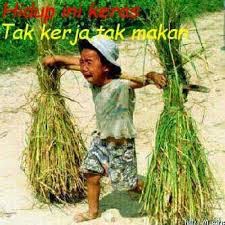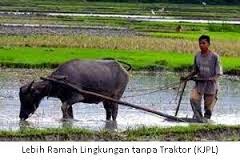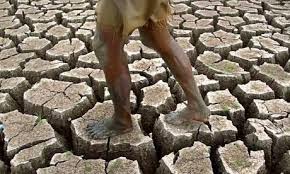 |
| Bapakmu nang di leh? hati2 kesandung !!! |
Koes Plus mengatakan “tongkat kayu dan batu jadi tanaman!” di satu sisi mungkin membuat
kita bangga akan anugerah alam yang diberikan, namun di sisi lain dapat membuai
kita dalam fatamorgana kesuburan sehingga kita lupa akan inovasi. Tanpa mengecilkan berbagai
pencapaian sektor pertanian di Indonesia,
harus kita akui pertanian kita seperti jalan di tempat. Kita boleh iri dengan
kemajuaan pesat tetangga-tetangga kita sesama negara berkembang, yang boleh
dibilang dulu mereka belajar dari apa yang kita lakukan, justru sekarang
berbanding terbalik beras dan beberapa komoditas kita masih impor, yang sangat
menyedihkan Negara kita kepulauan yang mempunyai pantai sangat luas garam saja
masih impor. Bahkan Indonesia terkenal pengekspor asap nomer wahid didunia
akibat dari pembakaran dan pembalakan hutan, Bukan tidak mungkin suatu
saat petani kita, guru, dosen, peneliti berbondong-bondong belajar mengenai
pertanian ke Negara tetangga
Salah satu contoh yang sebenarnya dulu pernah
dilakukan para petani tradisional kita yaitu pertanian terpadu padi denagn
bebek, yaitu melepas liarkan bebek berumur 3 mingguan diarea persawahaan, ada
beberapa manfaat yang di dapat:
1. Bebek akan bebas mencari makan sendiri
2. Dapat mengendalikan hama, seperti keong, ulat dll
3. Sebagai pengempur tanah
4. Kotoranyasebagai pupuk
5. Pada saat panen bebek pun siap dijual/dilanjutkan
untuk produksi telur
Bahkan di Lamongan pernah
dengar ada pertanian terpadu yaitu tambak ayam dan pisang (Tamyamsang)
Diatas areal pertambakan
dipelihara ayam dimana kotoran yang dihasilkan jatuh dimakan ayam dan pematang
tambaknya ditanami pohon pisang, ini merupakan program inovatif yang perlu
didukung dan dikembangkan sehingga petani tidak terfokus ke satu komoditas
saja.
Belanda dengan luas Negara hanya 41.526 km persegi (bandingkan dengan luas Indonesia yang mencapai Indonesia 1.919.440 km) mampu menjadi Negara dengan besaran ekonomi urutan 16 di dunia dan memiliki pendapatan perkapita 2% lebih besar bila dibandingkan dengan rata-rata di eropa, sekitar 20% perekonomian mereka di topang dari sektor pertanian. Bahkan sebagian dari wilayah daratan Belanda adalah daratan buatan hasil membendung air laut!, dapat dibayangkan teknologi yang mereka kuasai untuk menahan air sebanyak itu
Martin J Kropff, Rektor Universitas dan Research Wageningen, Den Haag mengatakan bahwa salah
satu kiat mereka dalam membangun industrialisasi pertanian adalah melakukan
investasi dalam kegiatan riset. Dari riset ini akhirnya digulirkan
inovasi-inovasi, yang salah satunya di bidang pertanian. Sekarang pertanian di
negeri kincir angina itu telah dijalankan dengan system yang modern,
direncanakan secara matang, menggunakan alat yang canggih dan keterampilan.
Inustri pertanian Bunga/tanaman hias
menjadi salah satu andalan di negeri belanda, mereka menggembangkan teknologi
yang mereka sebut tirai difragma untuk greenhouse, atapnya terlihat berwarna
belang-belang abu-abu dan transparan yang dikendalikan secara mekanik bisa
menutup dan membuka untuk mengatur suplai cahaya, carbondioksida, dan
kelembaban udara di sekitar greenhouse seperti yang di inginkan. Untuk
melakuakan itu semua cukup dengan mengatur beberapa tombol saja. Tidak hanya
itu, mereka juga menerapkan teknologi robotic unrtuk penyortiran tanaman,
pekerja hanya duduk ditempat sebagai operator saja.Belanda dengan luas Negara hanya 41.526 km persegi (bandingkan dengan luas Indonesia yang mencapai Indonesia 1.919.440 km) mampu menjadi Negara dengan besaran ekonomi urutan 16 di dunia dan memiliki pendapatan perkapita 2% lebih besar bila dibandingkan dengan rata-rata di eropa, sekitar 20% perekonomian mereka di topang dari sektor pertanian. Bahkan sebagian dari wilayah daratan Belanda adalah daratan buatan hasil membendung air laut!, dapat dibayangkan teknologi yang mereka kuasai untuk menahan air sebanyak itu
 |
Serupa dengan di Belanda, jepang yang
terkenal sebagai bangsa pengkreasi dan pencipta juga menerapkan pertanian
modern. Jepang selalu merencanakan pertaniannya secara jangka panjang, mungkin
yang paling terkenal dan terasa dampaknya sampai sekarang adalah kebijakan
nasional tentang konsolidasi lahan (1961). Kebijakan ini pada intinya melokalisasi lahan pertanian yang
tadinya terpisah-pisah dalam jumlah yang kecil sehingga kurang efesien menjadi
lahan yang terlokalisasi pada satu daerah dengan pengembangan infrastruktur
pendukung seperti jalan, saluran irigasi dll secara terpusat. Selain itu,
pemerintah Jepang memberi perhatian khusus terhadap sektor ini, seperti
pendirian sejenis koperasi bernama Japan Agriculture Cooperative (JA
Cooperative) yang secara baik mengatur pengadaan pupuk, benih, penjualan produk
hasil pertaniaan hingga bimbingan teknis untuk anggota-anggotanya, memberikan
subsidi untuk melindungi hak petani untuk hidup layak.

Yang menjadi pertanyaan mana
sumber alam Indonesia yang gema
ripa loh jinawe katanya? Tapi generasi mudanya
justru berlahan tapi pasti tidak tertarik lagi dibidang pertanian hal ini
disebabkan kebijakan pemerintah yang menganak tirikan petani sehingga menjadi sektor
terpinggirkan, kesimpulanya Negara/ tanah subur tidak menjamin rakyatnya hidup
makmur tapi faktor yang paling utama adalah pemberdayaan dan menyadarkan sumber
daya manusianya
Selamat pagi
Indonesia uda bangun belum? Ha…. ha…. Ha…..kok jek turu ae rek. !!!
“Sulthan Bird Farm” Peternak
Perkutut Bangkok
Hub : 081393875298.
Email:djekalmg@yahoo.com
Email:djekalmg@yahoo.com
Ds.
Langgeng, Gedong Boyo Untung, Turi - Lamongan







